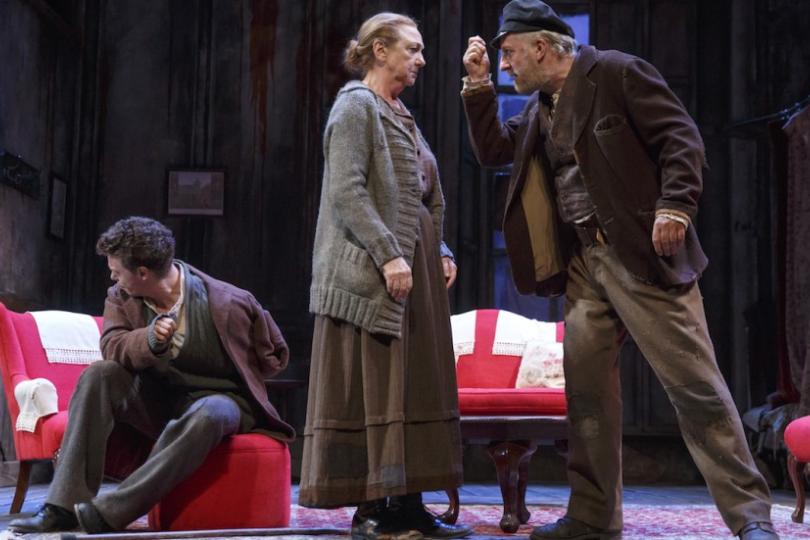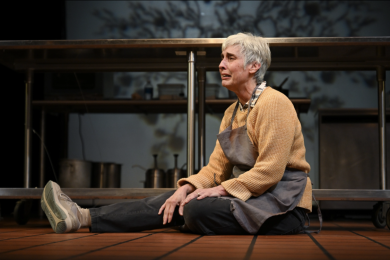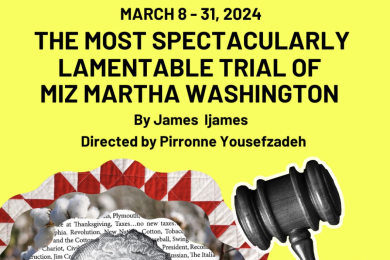Boxing with yourself

Joe Dowling does a brave thing by choosing Juno and the Paycock to close out his twenty-year tenure as the Guthrie’s Artistic Director. It was Dowling’s 1988 production of the play that put him on the map in the United States: the New York Times’s Frank Rich praised it for its “deep vision”, and Clive Barnes described it as “one of the greatest nights the New York theater has seen in years" for the New York Post.
This has made for some pretty intense local hype leading up to the Guthrie production. Say what you will (I know I have) about the Guthrie’s artistic choices, but Dowling has done a lot to ensure that the Guthrie continues to dominate the cultural conversation in Minnesota. Producing Juno as Dowling’s last Guthrie show is a nice nod to his Irish roots, as well as a reminder of the more serious plays that the Guthrie has sometimes staged extremely well, even amidst more crowd-pleasing fare like “My Fair Lady.”
But the fact remains that it would be hard for any production to live up to the reviews of Dowling’s original 1988 production. If you believe the New York critics, the symbolism of Séan O’Casey’s 1924 play seems to ooze from the dim, decaying walls of the Boyle family’s tenement, and the cast’s balanced and honest performances brought out both the comedy and the brutality surrounding a community beset by both civil war and extreme poverty. Even Howard Kissel of the New York Daily News, who was more reserved in his praise, said that the production “captured the soul of a nation."
How good is good enough?
The current staging, like the original, also features honest performances that provide insight into the Irish character, but its edges are somehow less sharp and its emotional colors less vivid than the 1988 reviews lead us to expect.
The program credits both Frank Hallinan Flood for the original set design and Michael Hoover for executing that design for the Guthrie, so I assume that we’re seeing a pretty close facsimile of the original set, which aims to recreate life in a tenement. Green mold drips down the walls, light filters in through cracked windows, and the sleeping spaces are cordoned off with tattered curtains. It is a space where life as a family of four – including two adult children – should feel grim and claustrophobic.
On the wide expanse of the Guthrie’s proscenium stage, however, the Boyle family has too much room to breathe. When family members retreat into the curtained back bedroom of this one-room apartment, they somehow can’t hear dialogue taking place on stage. Mary, the adult daughter, can enjoy a moment of peace and quiet as she puts on makeup at the kitchen table, while her mother Juno is occupied at the stove all the way across the room. The desperation of a family in dire financial straits is all there in O’Casey’s script, but it feels diluted in a room where the ceilings are too high and walls are too far apart.
The actors’ performances, like the set, are specific and well-executed, but their emotional immediacy is diffused. This is particularly true for “Captain” Jack Boyle (Stephen Brennan) and his drinking buddy, “Joxer” Daly (Mark Benninghofen), men who have made careers out of avoiding work and taking advantage of every possible opportunity for easy money and a quick drink. In their more slapstick moments, they are a pair of sad, alcoholic vaudeville clowns, but there is a threatening undercurrent to both characters that this production downplays. Captain Boyle (the “peacock”) is full of hypocritical bluster, but he also bullies his wife and has a potential for violence that only starts to come out later in the play. Joxer Daly, the opportunistic deadbeat, is even worse, but his villainy is more often played for laughs than for menace.
The effects of poverty
These nuances are particularly important in a play like this one, because unlike scripts where everyone has to learn something, the characters in “Juno” do not change much. O’Casey, a socialist and Irish nationalist, seems more interested in how the social and economic forces around his characters affect his characters’ behavior towards each other. Poverty leads Juno and Jack Boyle’s relationship to revolve around blame and shirking responsibility for financial hardship; in the meantime, their son Johnny, whose arm was blown off during the fighting, is clearly struggling with feelings of uselessness and memories of trauma. There should be a quiet desperation underlying every moment of the first act, but this desperation never quite materialized for me in this production.
So when the Boyle family unexpectedly comes into money, their relief was also less cathartic. Because the lows are not quite low enough, the highs are also less high – which also diluted the tragedy of the inevitable third-act fall. The resulting viewing experience was very polished, engaging, and at times moving or humorous, but lacking the emotional and political vibrancy that I looked forward to.
One clear exception to this was Sally Wingert as Mrs. Maisie Mulligan, the Boyles’ busybody neighbor. Not only did her characterization perfectly capture the brutally self-serving motivations behind a charming façade, but Wingert also highlighted the rich potential of O’Casey’s script, in which the crush of poverty brings out nastier sides of nearly all the characters.
Walking out of the 1988 production, Frank Rich describes the show has having left him with an eerie last impression; he calls the final image of the passed-out Captain Boyle an “unnerving double for the men we’ll step around in the street as we make our way… to the safety of home.” I can see why this image made Dowling’s career: at least in Rich’s eyes, the production was compelling and took provocative risks. I enjoyed the current staging, but it did not shake me as the original shook Frank Rich. Dowling knows how to direct an interesting play and get good performances from his actors, but it seems he didn’t dig as deeply or as darkly this time around.




